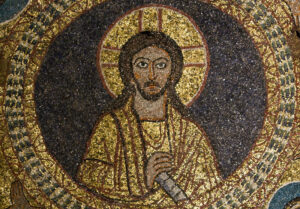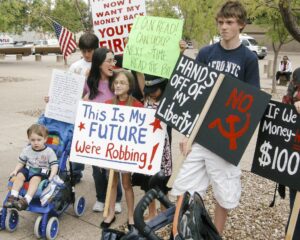Jonathan Tran’s new book, Asian Americans and the Spirit of Racial Capitalism (Oxford University Press, 2021) is an ambitious work. It deconstructs misunderstandings of race, excavates the real origins of race and racism, and makes constructive suggestions about fighting racism. Tran’s unique methodology and deep engagement with antiracist literature provide Christians with a new way to analyze race and a necessary critique of race reductionism. Informed by Black Marxism, Tran’s book spans the development of the model minority myth, Black, Asian, and white racialization, the notion of “divine economy,” and the relationships between theology, race, and revolution. A critique of Afropessimism even finds its way into the text. Asian Americans, is not just another scholarly work. It is an intervention, one that advances a clear argument often ignored in Christian treatments of race: in order to understand race and racism, we must understand their relationship to and dependence on capitalist political economy.
In a postscript entitled “Beyond Marxism,” Tran summarizes his main idea: “racism justifies dominative exploitation.” Because political economy explains race and racism “in terms of the historical and material contexts that produced and perpetuate race thinking,” it also “better explains what racism is, how it works, and what liberation entails.” This forms Tran’s conceptual polemic against “identarian antiracism” which he defines as “an approach to racism that begins and ends with racial identity,” whether that identity is understood as innate or socially constructed. Tran argues that identarian antiracism is so dominant in the academy and beyond that it “rises to the level of established doctrine,” and can therefore be called “the orthodox view.” Given the ongoing debates about class and race “reductionism,” which often run the risk of dismissing one in favor of the other, Tran’s work is extremely timely. By taking up Cedric Robinson’s theory of racial capitalism in 2021, Asian Americans provides a necessary challenge to an antiracist orthodoxy long in the forging—one that helped to hastily quench the revolutionary energies of the George Floyd rebellions.
Tran relies on two extended case studies to demonstrate how an analysis of the political economy of race might take antiracism in a new direction. Tran takes us from a Chinese settlement in the Mississippi Delta between 1868 and 1969 to a contemporary Asian-American church and its extended community in the historically Black Bayview/Hunters Point area of San Francisco. Asian Americans thus reads as a tale in two parts, threaded by Tran’s argument that political economy engenders both race and the process of racialization. His meticulous analysis of the relationships of exploitation among Delta peoples, who were respectively racialized as Black, white, and Chinese, is ruthlessly compassionate.
Tran begins with a discussion of the intricate development of the “model minority” myth. He goes beyond simply rehashing its familiar genesis in William Petersen’s notoriously anti-Black 1966 op-ed in The New York Times, “Success Story, Japanese-American Style,” or locating its presence in the contemporary moment. Rather, Tran offers a critique of the critiques of the model minority myth, which he considers a cottage industry of its own, tussling over the myth’s veracity and whether or not to disaggregate it and spotlight Pacific Islanders or Southeast Asian Americans instead. All of this misses and even precludes questions of political economy. For Tran, “race is created and deployed to justify hierarchical systems of domination,” and is not itself “conceptually basic.”
Tran then turns the myth on its head, positing that the late nineteenth century’s newly enfranchised African-Americans were the first to be made model minorities—a gate-keeping move that “came with Chinese naturalization and its possibility for enfranchisement.” This leads to Tran’s close study of the Delta Chinese and their grocery stores, as well as the political economy that structured their racialization in relation to that of Black and white Delta Mississippians. His primary source work vividly recounts Delta Chinese life, carefully detailing their daily life in a “moving picture of racial capitalism.” From one angle, the Chinese are redlined out of homes and schools by white wealth and power derived from slaveholding; from another, they are petty-bourgeois extractors of grocery income from Black people. Black and Chinese Mississippians are immiserated in different ways but within the same structure of white accumulation.
Tran does not dwell on these painful details in order to demonstrate moral failings, abounding as they are. Rather, these examples highlight material realities that unveil the political economy that makes such exploitative relationships possible—and naturalizes them through the ideology of race. Tran’s attention is on how white supremacy politically determined the economic relations that were already structuring “how the Chinese got to the Delta, the conditions of their arrival, their transition to the grocery store business, the success of their business model, and the relationships that unfolded in the course of its regular operations.” White supremacy produced Delta Chinese “entrepreneurship” as an “aftermarket” of entrenched racial capitalism.
Further, Tran believes that political economy—race’s beating heart—is elided when the Delta Chinese (and other Asian-Americans) are understood as trying to become white as an end in itself. What this loses is their “position of benefiting from a political economic order not of their making,” which required they both suffer and perpetuate “the racial antagonisms built into its ordering.” For the Delta Chinese “‘opportunism’ and ‘triumph’ each prove insufficient for capturing the complexity of the conditions they both inherited and exploited.” Meeting real needs in food deserts created by white supremacy does not absolve the Chinese grocers from the profits they extracted. Nor does Chinese predation on the means of Black survival represent the full extent of exploitation under racial capitalism.
Tran’s analysis of the Delta Chinese is unsparing but never unkind. I found myself grieving over the misery of Black and Chinese life under racial capitalism, as well as the unrealized possibilities for multiracial solidarity in the Delta. His attention to the role played by an emergent Delta Chinese Christianity provides the text’s bridge between past and present. Becoming Christian lent Chinese grocers respectability in the eyes of whites and offered their children access to education through school partnerships with the Southern Baptists. But Chinese Delta theology offered little alternative to participation in the Delta’s racist aftermarket. The fundamental question that takes Tran from the Chinese Delta Christians to Redeemer Community Church is, therefore, “what would it look like for Christians racialized as Asian American to do better?”
Tran’s second case study, Redeemer Community Church, is then introduced as an example of “what Asian American Christianity can accomplish.” Redeemer emerges in Asian Americans in more narrative fashion; readers feel that they know its church members and its cultural rhythms. Redeemer embodies Asian American Christians’ “integration of community and place amid racial capitalism’s displacing powers, their realization of a deep economy organically scaled to San Francisco, and their attempt to resource black children amid persistent antiblackness.” This attempt relied on two organizations founded by church members: Dayspring Partners, a software company (now a subsidiary of Redeemer), and Rise University Preparatory School, a neighborhood school. Redeemer, Dayspring and Rise Prep comprise a “microecology” of revenues, resources, and distributions all “coordinated under Redeemer’s unifying commitment” of redistribution “to serve the broader Bayview/Hunters Point ecology.”
Gentrification is the manifestation of racial capitalism that Redeemer sets itself against, Tran argues. It is gentrification that forms the backdrop for the ministry of Dayspring Partners, a for-profit created by Redeemer founding pastor Danny Fong. Dayspring resulted from Danny wondering if “one of the industries regularly blamed for pushing the poor to the margins might for a change prove to be a resource,” and if a software company “could extend the benefits of tech to surrounding communities of color.” Dayspring’s employees understood their ministry as faithfulness to place, leading them to “wed themselves to Bayview/Hunters Point” because “rather than ‘fix’ it, they wanted to be a part of it.”
Tran’s evaluation of Redeemer’s anti-gentrification work is couched. He acknowledges that, from an identarian perspective, the “optics” of a savior or capitalists looking for new sites of accumulation are not good. As in his section on the Delta Chinese, Tran is in his element when dissecting the identarian critique of gentrification and its elision of political economy, and he heads off their concerns deftly. But the final evaluation of Redeemer’s success comes not from Tran, but the Reverends Dee and Tyrone Hillman Jr., Black pastors that came to befriend Redeemer as it moved into their neighborhood. Reverend Dee Hillman describes Redeemer as “the hands and feet of Jesus,” with “friendships, rather, with people all over Bayview so what they do is never seen as invasive.”
Having anticipated readers’ identarian concerns about Redeemer, there is something final about a local Black voice affirming the church as an exception to the invasion of gentrification. Who better to have the last word than representatives of the community experiencing gentrification?
But Tran’s privileging of the Hillmans feels out of place as a way to close out the discussion of Redeemer’s role in and against gentrification. Why should a polemic that insists on the importance of political economy and Black Marxism ultimately rely on representation to vindicate the politics of Redeemer? Is it helpful to suggest that the Hillmans are capable of representing Bayview/Hunters Point, and thereby validating Redeemer? One might even ask if it is helpful for Asian-Americans to think that anyone is capable of “representing” someone else. Surely, Tran is aware that representation easily falls prey to identarian politics and often flattens differences within apparently stable identities. The mere assertion and representation of group identity is no guarantee of group liberation. As Stuart Hall put it in a seminal essay on the politics of representation, “there is no reason on God’s earth why [a] film is good because a black person made it … absolutely no guarantee that all the politics will be right because a woman does it.” Olúfẹmi O. Táíwò has recently suggested that representation often falls into “deference epistemology,” writing that “attention to spokespeople from marginalized groups could, for example, direct attention away from the need to change the social system that marginalizes them.”
Tran’s discussion of the political economy of gentrification is far more generative. As with his deconstruction of the model minority myth, Tran critiques the critique of gentrification by identarians, focusing on Derek Hyra’s work, which he thinks falls into a form of race reductionism. “The problem isn’t that in focusing on white gentrifiers Hyra ‘plays the race card’ but rather that he plays it too narrowly and thereby distracts from the fact that the whole deck of racial capitalism is stacked against anyone a race-based political economy relegates to the bottom.” Overdetermined notions of whiteness, anti-Blackness, and racial identity are insufficient to explain gentrification, and obscure “the actual determinates of black displacement … poverty and its antidemocratic antecedents and effects.”
Tran helpfully shifts the conversation from easily lampoonable white gentrifiers to the “whole network of oppressions carrying the force of history.” However, Asian Americans fails to evaluate Redeemer’s ministry against this very metric. Tran rightly heads off the identarian critique, which would dismiss Redeemer out of hand due to Asian-Americans ministering in a Black neighborhood. But he does not analyze Redeemer’s interaction with that network of oppressions to the same extent that he does with the Delta Chinese grocers.
In Tran’s own formulation, antidemocratic antecedents, poverty, and capital’s control of schooling are the motive forces behind gentrification. It would have been fruitful, then, to place Redeemer and Rise Prep’s models for fundraising and disbursement in conversation with the longstanding critiques of the nonprofit industrial complex and the organized movements that have arisen to fight it. For instance, the North American Autonomous Tenant Union Network is a movement that rejects the conciliatory politics, donors, and service model of nonprofits so that democratic control of unions stays in the hands of tenants (which they define as anyone who doesn’t have control over their housing).
In other words, my critique is not merely academic, but borne out by the experiences of movement organizers. One powerful example is Bbneoyle Heights’ Union de Vecinos, which played a major founding role in the citywide Los Angeles Tenant Union, itself a mainstay of the Autonomous Tenant Union network. Union de Vecinos was birthed after tenants were abandoned by “supposedly progressive nonprofits, including Dolores Mission, the nearby church that had organized with residents for years … grounded in liberation theology.” Faced with a vote on the “redevelopment” of their neighborhood by the Housing Authority of the City of Los Angeles (HACLA) that would see them evicted, tenants stood opposed, but were outvoted by the church’s board members, “who naively trusted HACLA’s vague promises that tenants would be able to return to the newly built units.”
Like the subjects of Asian Americans, residents of Boyle Heights were faced with “the larger systems that fundamentally structure our community’s lives.” They trace the injustice of evictions to “the deeper roots of these problems, like capitalism, US imperialism (particularly relevant for an organization rooted in a heavily immigrant neighborhood), white supremacy, and patriarchy.” As a result of this analysis, Union de Vecinos understands that “building a deeply radical movement to challenge these systems requires building and wielding the autonomous power of the poor.”
These questions and cautions are not intended to dismiss Redeemer. Rather, they are a call for fidelity to Asian Americans’ own spirit of sober political-economic critique. This is partly because Redeemer feels so utterly familiar to me. As Tran notes, the church’s founding was inspired by members’ experiences in the Oakland Urban Project, one of the many urban missions/social justice programs run by the evangelical InterVarsity Christian Fellowship, and a cousin to the Los Angeles Urban Project where I was involved as an undergraduate. For a summer, I worshiped weekly in a church just three miles from where Union de Vecinos was formed, and some of us served at the Dolores Mission.
That summer was profoundly formative for me, and the intense religious commitment of my fellow students and the long-term neighborhood ministers is hard to convey in words—Tran comes close in his description of Redeemer, which he calls a “narrow-is-the-road-that-leads-to-life feel,” of a commune. Today, I wonder if a sustained critique of political economy might have saved our Christian commitment to justice from being mired in the non-profit service model, and from missing racial capitalism by focusing on its aftermarkets.
Asian Americans presents a successful tech company redirecting its profits into a neighborhood fighting gentrification (sometimes literally, in the instances of violent hate crimes against a growing Chinese American population) and a quality, affordable private school nestled there. The book’s spirit of critique calls me to look at this and ask: what political-economic function does the poverty of Bayview/Hunter’s Point play? Who, or what does it serve? If these questions are not surfaced, and the functions and beneficiaries of poverty are not confronted, won’t racial capitalism necessarily raise up new subjects to impoverish, new subjects to replace those that Redeemer schools or serves out of poverty? Won’t it just produce new Bayview/Hunter’s Points by other names, if Bayview/Hunter’s Point as we know it is redeemed? What precisely does Redeemer’s work do then, in terms of political economy?
The harshness of these questions might seem like a failure to “distinguish friend from foe,” which Tran cautions against with critiques of complicity. But my questions for him are constructive, not rhetorical. I am not cynically demanding that Redeemer single-handedly redeem BVHP and overthrow racial capitalism, or else give up. I am simply contesting the revolutionary quality that Tran confers upon “the church being the church.” Here, Tran’s postliberal influences become clear, and his attempt to distinguish Christianity from politics strains under his own analysis of capitalism. His claim that “the primary political key of Christian witness is not resistance but proclamation,” creates a false dichotomy between these two keys. If the critique of political economy finds that a proclamation fails to resist what Sophie Lewis calls “the sad and evil world, this present state of things,” then it is necessarily an insufficient Christian proclamation.
I am also asking Tran for the material experiences that have informed his postscript, in which Marxism falls short of “materially producing revolutionary community and action,” and Redeemer becomes the satisfactory replacement for failed Marxist politics. Redeemer is clearly doing God’s work in many ways, but nowhere does Tran offer a good reason to call it “revolutionary.” Declarations that Marxism is moribund or dead are common among academic theologians, but the problems mentioned above suggest that a new engagement with Marxism may be called for, not a postmortem.
Despite these criticisms, Tran has set a new standard for Christians who want to intervene in the struggle against racism and capitalism. The prevailing antiracist orthodoxy that Tran critiques is not only identarian, but a counter-revolutionary cooptation of the struggle against racism. Both prongs demand a response rooted in the critique of capitalist political economy. We should affirm with Tran that we need an approach that “reaches back to a trusted mode of analysis that … will not get at everything that racism is and does, but … gets at what can be managed, and in the last resort lived.” Met with such a living challenge, the antiracist orthodoxy of the hour may just be shattered.
Jaira Koh is a doctoral student at Boston University.




